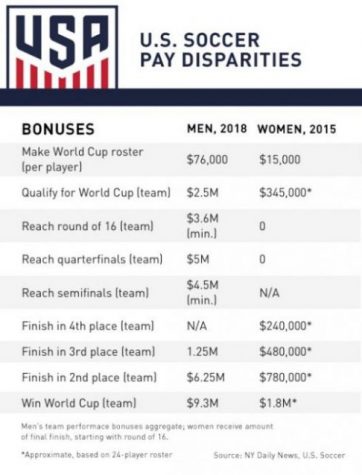My Thoughts Exactly.
February 21, 2018
The gender wage gap is real, whether you believe it or not.
There is an argument that the gender pay gap simply doesn’t exist. After a long dispute with a fellow classmate, he believes there are several main reasons responsible for the disparity in men and women’s pay: maternity leave, men are harder workers, and when it comes to athletics, “men are biologically better than women at sports.”
It was argued that “bad life choices” made by women are the real reason behind the gap. This is, in itself, an absurd oversimplification. One of these “bad choices” is becoming pregnant and taking up to 12 weeks of unpaid maternity leave. Of course, the fact that some companies now offer paternity leave is ignored. Although some women choose to stay home or cut back their hours after having children, most do not, but they do have a hard time finding a full-time job that affords them any kind of flexibility. Plus, women face a well-known “motherhood penalty.” They’re less likely to be hired for jobs once they have children — unlike men, whose prospects improve.
Another part of the argument regarding the wage gap was the “bad career choices” women make. He showed me this video that compares the difference in dominated gender fields. This video, made by Prager University, which, by the way, isn’t a university. It’s just a website. The producer is a history major from Brooklyn College, who failed to complete his masters at Columbia University, dismisses the gender pay gap by asserting that women tend to work in lower-paying (i.e., traditionally “female”) fields, like teaching, nursing, and social work. Although men typically dominate the higher paying jobs, the issue is a wage gap exists when a man and woman work the same job. Women get paid less. Research has shown that even when women enter traditionally “male” fields, they make less. In fact, research looking at pay changes over decades has shown that when more women enter a traditionally male field, pay within that field begins to decline. As The New York Times reported, when more women began working in parks or running camps, median hourly wages declined by 57 percentage points. Conversely, when more men enter a traditionally female field, wages go up. “It’s not that women are always picking lesser things in terms of skill and importance,” a researcher told The New York Times. “It’s just that the employers are deciding to pay it less.” There are many concrete and specific examples of the ways in which the pay gap is present in women’s lives today. (See hospital doctors, Jennifer Lawrence, and even Buffer, a company obsessed with eliminating the pay gap that took a hard look at itself and found…a pay gap.)

One of the the biggest points argued, while it was certainly disheartening, is that male athletes get paid more because they are better athletes. I referenced the Women’s USA soccer team. The Women won the 2015 World Cup, while the Men’s team failed to qualify. That year, the women raked in $23 million in revenue, while the men only brought in $16 million. According to Pbs.org Newshour, that same year “women earned four times less than the men while performing demonstrably better. The women won their third World Cup, while the men have not advanced past the quarterfinals in the modern era.”
“If I were a male soccer player who won a World Cup for the United States, my bonus would be $390,000,” wrote Carli Lloyd, co-captain of the national team and FIFA’s 2015 World Player of The Year, in an essay for The New York Times. “Because I am a female soccer player, the bonus I got for our World Cup victory last summer was $75,000.”
“This isn’t about a money grab,” she continued. “It’s about doing the right thing, the fair thing. It’s about treating people the way they deserve to be treated, no matter their gender.” Five members of the U.S. women’s national soccer team had to file suits against the U.S. Soccer Federation to push for the same pay and bonuses as their male counterparts. It also makes for kind of a perfect, high-profile example of the pay gap in action just in time for Equal Pay Day.




Caden S Jackson • Feb 22, 2018 at 1:34 pm
@student, Well said, very well said.
Dean Johnson • Feb 22, 2018 at 10:37 am
According to Payscale.com
Average yearly salary of Garabage Person – $37,000
Average yearly salary of teacher – $45,000
Very broad comparisons.
Many factors can contribute to the wage gap besides just salary comparisons. Many women that work professionally have to balance it with also having a family. Women have to pause their careers to have children. So, when we are talking about management positions, this contributes to men being able to obtain management positions over women.
Now, some might say that is the woman’s choice to have a family, but is it fair to women to have to choose being a mother or a successful professional?
Josh • Feb 22, 2018 at 10:29 am
@Student A, Perhaps because it is illegal to hire based on sex alone? (https://www.eeoc.gov/laws/practices/) The decision you bring up seems to fall under that.
Caden S Jackson • Feb 22, 2018 at 1:37 pm
@Josh, its also illegal to pay people of different sex’s differant wages (The Equal Pay Act of 1963 is a United States labor law amending the Fair Labor Standards Act, aimed at abolishing wage disparity based on sex (see Gender pay gap). It was signed into law on June 10, 1963, by John F. Kennedy as part of his New Frontier Program.)
Josh • Feb 22, 2018 at 2:31 pm
@Caden S Jackson, You’re right, but I’m not sure what that has to do with the law I brought up? That would be a valid argument against this article, but I did not state whether the wage gap was real or not, I only responded to “Student A’s” question, so I don’t think the Equal Pay Act applies to anything I said.
Josh • Feb 22, 2018 at 10:00 am
@student, >Also, the wage gap is only because men go for different jobs than most women.
“the issue is a wage gap exists when a man and woman work the same job.”
Also, was it *really* necessary to hide behind a fake name to discuss your opinion?
Dean Johnson • Feb 21, 2018 at 5:46 pm
I really never thought about the men’s and women’s soccer comparison. I thought you brought up some interesting points. I am curious about one thing, what would be the approximate amount of revenue the men’s team would have generated, if they would have won the world cup?